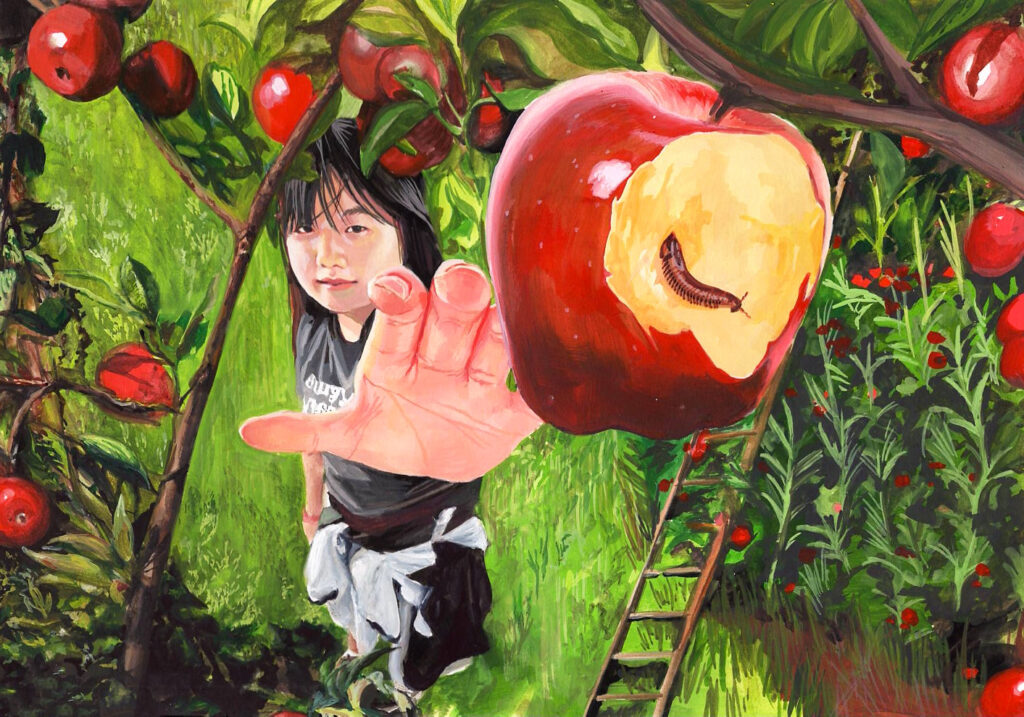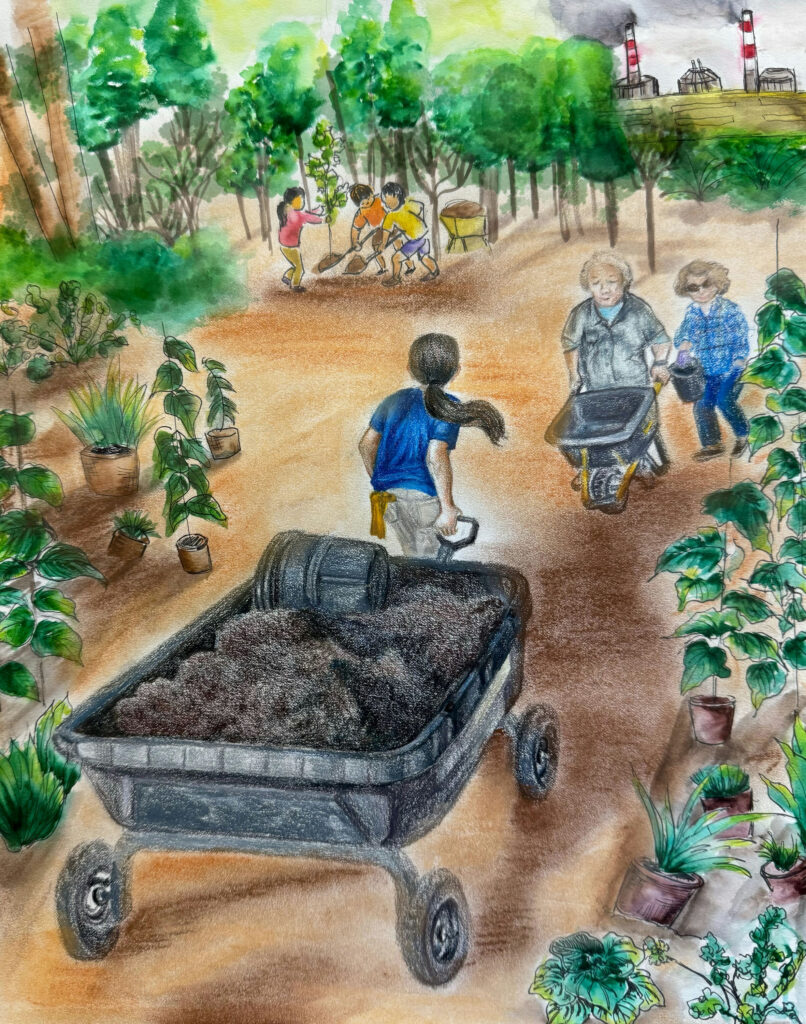
Crops in Crises: How Climate Change is Threatening Your Favorite Foods
April 23, 2025By Stella Hong, 2025 Future Blue Youth Council member
Cover photo: The Starting Point, Mai Cao Ngoc, 2023
Meals are a sacred part of every day. The time we spend savoring the nostalgic flavor of our parents’ cooking, sharing dishes passed down through generations, or simply enjoying lunch with friends is essential to our physical and mental well-being. Yet climate change is threatening to take this all away.
Climate change, the long-term shift in the Earth’s average temperatures and weather conditions, is primarily caused by our use of fossil fuels, such as coal, oil, and gas.1 These greenhouse gases trap heat in the atmosphere, causing unnatural shifts in our climate that have a ripple effect throughout the ecosystem.2 For our food supply, which relies on a delicate balance of temperature, rainfall, and nutrition, these changes are disastrous.
In 2024, the world saw its hottest year on record, with global temperatures exceeding the critical 1.5 °C mark1 – a number deemed to cause “extreme and irreversible climate effects” if exceeded.13 Yet this number was surpassed just last year, resulting in an increase in extreme weather events, such as heatwaves, droughts, flooding, and cold snaps.1 Critical crops like grains, potatoes, cocoa, and olive oil were devastated by these changes.14 Prices of these foods skyrocketed, and communities who relied on the production of these foods were devastated. In rice farms in India, which account for 40% of world rice exports, late and heavy rains destroyed many young rice seedlings, causing a major ban on rice exports.15 The ban on exports caused a sharp increase in the price of rice, affecting the millions of people who rely on this essential grain.14
These changes in temperature not only impact the crops themselves, but also pollinators and pests that rely on these plants to survive. Pollinators like butterflies and bees emerge when temperatures warm, which is typically when plants bloom.2 However, irregular temperatures can cause a mismatch between when plants bloom and when bees emerge, leading to a decrease in crops that are pollinated.2 Conversely, pests may become more abundant and destructive.2 Many pests are limited in their geographic range to tropical climates. However, as temperatures warm and previously uninhabitable areas become suitable for these pests, they will become more widespread. Many of these areas are unadapted to these pests, and, thus, will suffer even greater consequences.2
 Fragile Harvest, Jamie Song, 2024
Fragile Harvest, Jamie Song, 2024
For workers whose livelihoods depend on agriculture, climate change also poses a significant threat. Because agricultural workers are often exposed to the elements for long periods, severe heat and extreme weather can put them greatly at risk for heat-related illnesses, such as heat stroke and sunburns.7 Furthermore, inhaling air pollution caused by wildfires or ground-level ozone can result in severe respiratory illnesses. Communities that rely on access to cheap and nutritious foods may also experience severe threats to their health. Over 2.33 billion people experience food insecurity, and climate change threatens to increase this number drastically.9 Many households rely on staple grains like rice, wheat, oats, or corn, which are affordable and filling. Indigenous communities often rely on locally produced crops, such as taro, breadfruit, and mango in the Pacific Islands, which are not only affordable and nutritious, but culturally important. Even a small decrease in crop yield could inflate the prices of these foods, making them inaccessible to many people. Over 2.6 billion people rely on agriculture to sustain themselves, and the economic and health risks posed by climate change can disrupt the safety and security of families.8
 Braceros, Jacquelyn Varela, 2024
Braceros, Jacquelyn Varela, 2024
Although the threat of climate change may seem insurmountable, researchers and farmers around the world are finding ways to adapt, tapping into both ancestral knowledge and innovative technologies. Historically, many indigenous tribes have used regenerative farming techniques, such as “The Three Sisters” planting, in which corn, beans, and squash are grown together, creating a symbiotic relationship that can increase yields and improve soil quality.16 Now, many farmers are adopting these methods in commercial practice. Not only do these methods promote biodiversity, but they can help remove carbon dioxide from the atmosphere, reduce water consumption, and bolster soil health, becoming a powerful tool against climate change.10
Other farmers are harnessing novel advancements in growing methods, such as the development of hydroponics, which is a farming system that requires no soil. Hydroponics allows plants to be grown in a nutrient water solution that is recycled through the system, reducing water use while increasing yield.12 Because no soil is required for hydroponics, it also offers a revolutionary advancement in urban agriculture. Even through actions as simple as reducing our food waste, we can help to make a difference.
 Rebuilding Hope, Carrie Li, 2024
Rebuilding Hope, Carrie Li, 2024
The next time you enjoy a meal with your family and friends, pause and think about where that food comes from. While it may be difficult to imagine a world without foods as simple as bread or rice, it is dangerously close to becoming a reality. Unless we all strive to make a change, our favorite foods may soon disappear.
Works Cited
- British Broadcasting Corporation. “What Is Climate Change? A Really Simple Guide.” BBC News, 10 Jan. 2025, www.bbc.com/news/science-environment-24021772.
- EPA. “Climate Change Impacts on Agriculture and Food Supply.” Www.epa.gov, 6 Feb. 2025, www.epa.gov/climateimpacts/climate-change-impacts-agriculture-and-food-supply.
- USGCRP. “Fourth National Climate Assessment.” Globalchange.gov, 2015, pp. 1–470, nca2018.globalchange.gov/chapter/10/.
- Ewing-Chow, Daphne. “Here Are the Foods Hit Hardest by Climate Change in 2023.” Forbes, www.forbes.com/sites/daphneewingchow/2023/12/31/here-are-the-foods-hit-hardest-by-climate-change-in-2023/.
- Gashler, Krisy. “Report: Warmer Planet Will Trigger Increased Farm Losses | Cornell Chronicle.” News.cornell.edu, 18 Jan. 2024, news.cornell.edu/stories/2024/01/report-warmer-planet-will-trigger-increased-farm-losses
- Igini, Martina. “2024 Saw Highest New Climate-Related Displacements since 2008.” Earth.org, 20 Mar. 2025, earth.org/extreme-weather-events-in-2024-led-to-highest-number-of-new-displacements-since-2008/.
- “Climate Changes Health: Food and Agriculture.” Apha.org, 2024, www.apha.org/topics-and-issues/climate-health-and-equity/agriculture.
- “2.6 Billion People Draw Their Livelihoods Mostly from Agriculture | Convention on Biological Diversity.” Www.cbd.int, 26 Nov. 2018, www.cbd.int/article/biodiversityforfood-1.
- United Nations. “Global Issues: Food.” United Nations, United Nations, 2024, www.un.org/en/global-issues/food.
- Morrison, Rose. “11 Ways Farmers Are Adapting to Climate Change.” Earth.org, 26 Oct. 2023, earth.org/11-ways-farmers-are-adapting-to-the-unpredictability-of-climate-change/.
- Fiolhais, Marta. “The Indigenous Roots of Regenerative Agriculture.” Rainforest Alliance, 9 Aug. 2023, www.rainforest-alliance.org/insights/the-indigenous-roots-of-regenerative-agriculture/.
- USDA. “Hydroponics | National Agricultural Library.” Www.nal.usda.gov, 2024, www.nal.usda.gov/farms-and-agricultural-production-systems/hydroponics.
- Chu, Jennifer. “Explained: The 1.5 c Climate Benchmark.” MIT News | Massachusetts Institute of Technology, 27 Aug. 2023, news.mit.edu/2023/explained-climate-benchmark-rising-temperatures-0827.
- Edmond, Charlotte, and Rebecca Geldard. “Prices for These Crops Are Most Impacted by Climate Change.” World Economic Forum, 12 Feb. 2024, www.weforum.org/stories/2024/02/climate-change-food-prices-drought/.
- Jadhav, Rajendra, et al. “India Imposes Major Rice Export Ban, Triggering Inflation Fears.” Reuters, 20 July 2023, www.reuters.com/markets/commodities/india-prohibits-export-non-basmati-white-rice-notice-2023-07-20/.
- Marsh, Emily. “The Three Sisters of Indigenous American Agriculture | National Agricultural Library.” Www.nal.usda.gov, 2021, www.nal.usda.gov/collections/stories/three-sisters.
